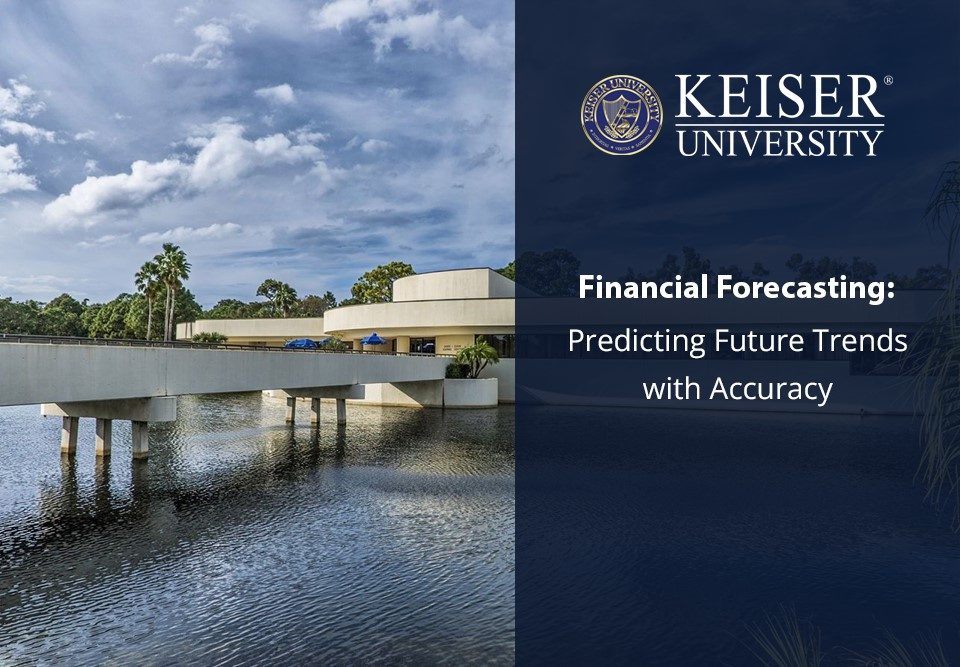In this day and age, anyone with an interest in professional finance budgeting should be intimately familiar with financial forecasting. If you want to know where your current and planned business operations will place you down the road, this key estimation method can provide an accurate map to your desired destination.
What Is Financial Forecasting?
A highly precise form of finance projection, a forecast draws upon large and diverse amounts of data to predict future fiscal conditions in the wake of specific organizational operations and management decisions. While projections are often based on pure theory and conjecture, forecasts are always based on concrete information from the past and the present as well as data-driven projections of ongoing financial trends.
Definition of Financial Forecasting
Succinctly defined, financial forecasting is a process that trained professionals use to make educated estimates about financial states in both the near and distant future. Because they are based on accurate information and reliable modeling, financial forecasts are imperfect yet still highly reliable.
Importance of Accurate Financial Predictions
Financial forecasts are excellent tools for businesses that want to make sound choices and strategic plans. Any business owner or administrator who fails to prioritize those risks falling behind a savvy competitor that does.
Historical Development of Financial Forecasting
Although financial forecasting is widely regarded as a distinctly modern practice, its roots date back roughly a century to the early formulas and models of pioneers such as economist Irving Fisher. With the rise of computer technology in the 1950s and 1960s, financial modeling truly took off. After all, computers made it extraordinarily easy to process and analyze substantial amounts of information.
By the late 1990s, businesses of all sizes had entered the financial forecasting arena thanks to widely accessible spreadsheet software such as Microsoft Excel and Lotus 1-2-3. Today, financial forecasting is a ubiquitous practice in nearly every business market, sector and industry.
Key Components of Financial Forecasting
While financial forecasting models and methods can be quite diverse and complex, they typically incorporate the same basic elements. Crucial components of financial forecasting include:
- Revenue projections – Financial statements that estimate how much money a business will earn in the future.
- Expense projections – Financial statements that estimate how much money a business will spend in the future.
- Cash flow analysis – Finance projection processes that track and predict how much money flows into and out of a business.
Financial Forecasting Methods
To conduct financial forecasting effectively and efficiently, specialized professionals have developed a broad yet refined spectrum of processes and techniques. In terms of fundamental methodology, financial forecasting generally falls within one of two general categories: qualitative and quantitative.
Qualitative Methods
True to its name, the qualitative approach to business research and forecasting involves the identification, explanation and application of various qualities that are most likely to impact future finances. Qualitative data yields descriptive information that may include solid facts but does not include exact numbers, statistics or degrees of measurement.
Expert Judgment and Market Research
Two of the most prevalent qualitative methods of financial forecasting are expert judgment and market research.
Expert judgment in financial forecasting involves drawing conclusions and planning for the future based on the specialized skill, experience and knowledge of one or more experts in a particular subject area. Businesses can assess this expertise according to reliable criteria such as educational background and career accomplishments. However, it is essential to realize that expert judgment is only as reliable as the experts who give it. In their article “Expert Judgment and Risk Perception,” Rolf Skjong and Benedikte H. Wentworth warn that multiple “problems associated with using expert judgments stem from the lack of adequate understanding and treatment of biases.”
More objective, market research refers to the systematic design, collection, interpretation and reporting of information to help marketers solve specific marketing problems or capitalize on marketing opportunities. It is a process for gathering information of value that is not currently available to decision-makers and answers key questions, such as: Which market is best suited for my products? How much will consumers pay for my products? What challenges do my market competitors present?
Quantitative Methods
Quantitative data yields empirical information that can be communicated purely through numbers. The quantitative approach eliminates much of the problematic subjectivity that goes hand in hand with the qualitative approach.
Time Series Analysis and Regression Analysis
Time series and regression analysis are distinct but complementary quantitative financial forecasting approaches that employ different methods and have different applications. The time series analyst works with ordered data that is dependent on time, whereas regression analyst works with independent data that is random in nature.
Using techniques like decomposition, autocorrelation and smoothing, time series analysis allows researchers to detect patterns in data over time and project those patterns into the near and far future. This makes it a valuable tool for financial forecasting.
Regression analysis, by contrast, is far better at approximating and describing the impact of various undetermined factors on an eventual outcome. “Regression analysis is a set of statistical methods used for the estimation of relationships between a dependent variable and one or more independent variables,” writes Sebastian Taylor of the finance industry education and certification organization CFI. “It can be utilized to assess the strength of the relationship between variables and for modeling the future relationship between them.”
Mixed Methods
As each approach has its unique benefits and limitations, qualitative and quantitative financial forecasting techniques are often used in tandem. By employing “mixed” or “hybrid” methods, forecasting professionals can counter the imprecision of the qualitative approach with exact numerical figures and the inflexibility of the quantitative approach with carefully examined judgments.
Mixed methods of market research, also known as hybrid market research, combines qualitative and quantitative research methods in a single study to gain a more holistic, well-rounded understanding of a research topic.
Best Practices for Accurate Financial Forecasting
Whether you favor a qualitative, quantitative or hybrid approach, you should follow some basic best practices to strive for exactitude and reliability in financial forecasts. Below are just a few essentials to consider at various stages of the financial forecasting process:
Realistic Assumption Setting
Wishful thinking can undermine even the most carefully formulated financial forecasting plan. So, before you begin the forecasting process, it is critical to be honest with your existing prospects and set objectives that are both pertinent and achievable. Furthermore, you should take care to choose precise goals that are easily measurable. Otherwise, it is more difficult to objectively assess the relative success or failure of your forecasting efforts.
Continuous Monitoring and Adjustment
While progressing toward your established objectives, you must track that progress closely to ensure you remain on course. Close monitoring can also help you detect methodological and operational flaws as well as inconsistencies in your financial forecasting activities.
Collaboration Across Departments
Financial forecasting can benefit tremendously from cross-functional collaboration in areas that include sales, budgeting, marketing and operations. “For instance, collaborating with the marketing team allows you to gain insights into market trends, customer behavior and promotional campaigns,” writes Priyaanka Arora for the forecasting software provider Pigment. “By incorporating this information into your financial models, you can accurately forecast sales and identify potential growth opportunities.”
Building a Unified Forecasting Team
Effective collaboration begins with cohesive team building. No matter how diverse your forecasting team happens to be, it is vital that it shares common goals and agrees on unified approaches to attain them.
Challenges in Financial Forecasting
Despite closely adhering to established best practices for accurate financial forecasting, professionals may encounter any number of obstacles and unexpected developments. However, you can handle these challenges adeptly with the right outlook and a little extra planning.
Dealing With Uncertainty
Some level of uncertainty is baked into the financial forecasting process. Even when they are based on accurate information and use sound methods, financial forecasts are nothing more than educated guesses. As financial writer and Certified Financial Planner David Rodeck puts it, “Forecasting is a scientific discipline, but ultimately, past performance cannot predict future outcomes, requiring decision-makers to embrace some degree of risk when using them to inform long-term plans.”
Data Quality Issues
As the old saying goes, “Garbage in, garbage out.” In the world of financial forecasting, this means that your final forecast will only be as accurate as the data that you use to create it. Therefore, one of the most fundamental challenges to financial forecasters is acquiring a sufficient amount of raw data that is both relevant and trustworthy. Though it may be tempting to input data of lesser quality into your forecasting model, your projections will be less useful because of it.
Model Limitations
After you have confirmed the highest quality of data, you must ensure you are plugging it into the right financial forecasting model for your purposes. In other words, choose a model with the right amount of complexity and specificity to achieve your established objectives. Your model must be based on the right predictive assumptions and take into consideration the realities of existing market factors.
Future of Financial Forecasting
Looking forward, experts see financial forecasting becoming ever-more important for organizations of all kinds. Real-time data and AI/machine learning are just two factors driving its expansion.
Increasing Use of AI and Machine Learning
Due to their incredible ability to rapidly process massive volumes of information, artificial intelligence (AI) and machine learning have played an integral role in financial forecasting for quite some time. As these technologies continue to progress and evolve, their applications in the worlds of business and finance will only proliferate.
Growing Importance of Real-Time Data
When predicting financial trends, up-to-date information is essential. Fortunately, advanced digital technology allows specialized professionals to access a wealth of financial and business data in real time. Every minute matters when developing a financial forecast, so organizations are racing to source high-quality economic, market, consumer and competitor information as quickly as possible. “With the power of real-time financial data, forecasting becomes more accurate, budgeting becomes more flexible and technology drives a more profitable company,” writes business consultancy AlixPartners.
Learn More About Financial Forecasting Methods
Interested in taking a deep dive into the world of financial forecasting? Consider pursuing a graduate degree at Keiser University—offering programs including a Master of Science in Financial Technology (Finance Technology MS), Master of Accountancy (MAcc) and Master of Business Administration in Accounting (Accounting MBA). For more information about any of these practical and exciting degrees, contact a Keiser graduate school admissions counselor today.






 The instructors at Keiser University impacted my life. They believed in my ability to become a great graphic designer, regardless of how I felt about my skills. KU helped to prepare me for the real world and got me to where I am today.
The instructors at Keiser University impacted my life. They believed in my ability to become a great graphic designer, regardless of how I felt about my skills. KU helped to prepare me for the real world and got me to where I am today.
